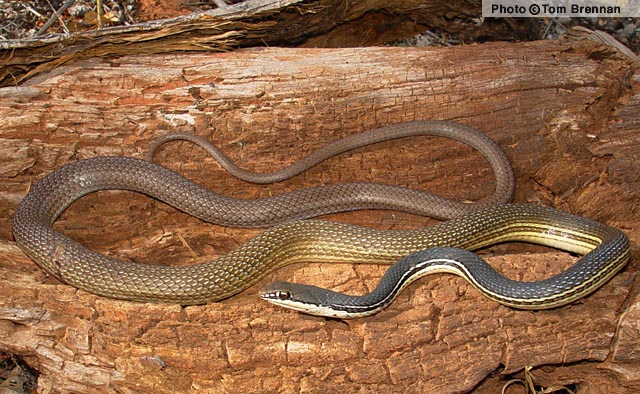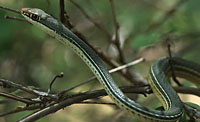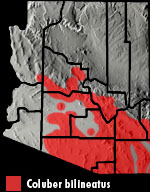Online Field Guide to The Reptiles and Amphibians of Arizona



Yavapai County, AZ
 Cochise Co., AZ |
| SONORAN WHIPSNAKE Coluber bilineatus |
Non-Venomous
|
| DESCRIPTION: A long (up to 1,778 mm or 70″ in total length), slender snake with blue-gray to gray-green coloration on the neck grading to yellow-green at mid body and gray-brown toward the tail. There are two thin, white stripes on each side of the body extending from the neck to about mid-body before melting into the background color. On the mid-section a pair of light dots marks the anterior edge of each dorsal scale. The underside is white to cream grading to pale yellow under the tail. The eyes are large and the pupils are round. The scales are smooth. The lack of side stripes on the posterior portion of this snake’s body distinguishes it from the similar looking Striped Whipsnake which has side stripes running from neck to tail. DISTRIBUTION: This snake is found in most of the sub-Mogollon Rim mountain ranges of south-central and southeastern Arizona at elevations ranging from 1,000′ to about 7,000′. HABITAT: It inhabits a variety of biotic communities including Arizona Upland Sonoran Desertscrub, Semidesert Grassland, Interior Chaparral, Madrean Evergreen Woodland, and the lower reaches of Great Basin Conifer Woodland. This snake is usually found above the flats on mountain slopes and canyons, in foothills, along ridges, and on steep rocky bajadas.BEHAVIOR: This very fast moving, alert, diurnal predator forges in the mid-morning sun, often hinting with its head elevated high off the ground. It is primarily a ground-dweller but it spends some time in trees and often flees into the high branches of trees when threatened. It occasionally sleeps in trees on warm, humid nights. It hibernates during the cold months of late fall and winter. When captured it does not hesitate to bite.DIET: This snake actively forages for lizards, snakes, bats, mice, rats, other small mammals, birds, and amphibians.REPRODUCTION: Mating takes place in spring and a clutch of up to 13 eggs is laid in summer. By Thomas C. Brennan Bartlett. 2000. Snakes of North America: Western Brennan, T. C., and A. T. Holycross. 2006. A Field Guide to Amphibians and Reptiles in Arizona. Arizona Game and Fish Department. Phoenix, AZ Brennan, T. C., and A. T. Holycross. 2005. A Field Guide to Amphibians and Reptiles of Maricopa County. Arizona Game and Fish Department. Phoenix, AZ Degenhardt, W. G., Painter, C. W., and Price, A. H.. 1996. Amphibians and Reptiles of New Mexico. University of New Mexico Press. Albuquerque. Fowlie. 1965. The Snakes of Arizona. Azul Quinta Press, Fallbrook, California Stebbins. 1985. Western Reptiles and Amphibians. Houghton Mifflin. New York, |
|
Visit Partners in Amphibian and Reptile Conservation:


HOME
Copyright © 2023, Arizona Game and Fish Department. All rights reserved.
If you make use of the textual contents of this site in reports, publications, etc. please cite and credit the author(s) and photographer(s). All photos on this website are copyrighted. However, those found in the species account section may be used for any noncommercial scientific, educational, or conservation purposes provided that photographs are not altered and continue to bear the copyright symbol and name of the photographer. Please contact the photographer regarding commercial use of copyrighted photographs.










